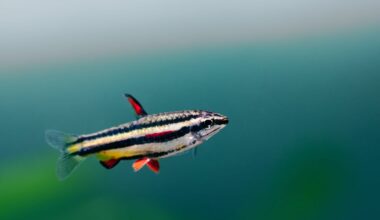Finding suitable goldfish tank mates is harder than it seems. While hardy, these fish have specific compatibility needs that you can’t ignore if you want them to thrive.
This guide breaks down what to look for in a goldfish tank mate, and lists our favorite species for you to consider.
Table of Contents
What Fish Can Live with Goldfish?
While goldfish are indeed beautiful and iconic enough to enjoy on their own, they make great additions to community tanks as well. Peaceful and playful, goldfish can thrive in a multi-species environment.
However, curating a community habitat with goldfish is not as easy as it seems.
The trickiest part of creating a flourishing community with these freshwater fish is choosing compatible goldfish tank mates. Goldfish are unique compared to most tropical fish in the trade. As a result, there are several traits to consider for potential tank mates.
Check out the most important ones below.
Low Temperature Requirements
The first thing you can use to narrow down your search for goldfish tank mates is the preferred temperature range.
In the fishkeeping community, goldfish are considered cold water fish. Of course, these fish still need relatively warm waters to stay healthy. But when you compare a goldfish’s comfortable temperature range to other popular species, there’s a big difference!
You see, goldfish hail from cooler mountain streams. They are not from tropical environments like a vast majority of species in the trade.
Goldfish can usually live comfortably in temperatures between 65°F and 75°F. Some varieties prefer even cooler climates!
Generally, goldfish do best in aquariums that don’t have any additional heating sources. For this reason, species that require ultra-warm waters are out of the question.
Easy-Going Temperament
For the most part, goldfish are docile and easy-going. They aren’t territorial either.
You should avoid any species that have a tendency to exhibit any forms of aggression. Goldfish aren’t capable of defending themselves against high-strung fish. This is especially true with fancy and or slow-moving varieties.
Furthermore, putting an aggressive or territorial fish into the mix could cause undue stress for both parties. Goldfish like to make use of the entire tank. They know no boundaries, which could be a problem for fish that want to claim space.
The constant back-and-forth is not healthy for any fish involved, so keep personalities relatively similar.
The Right Size
Here’s a trait that many fail to consider. When you’re talking about goldfish tank mates, medium-sized fish are the way to go. Around three to four inches long is ideal. However, you should really match the size of the companion fish to your goldfish.
Author Note: Goldfish have strong appetites. They are constantly searching for food and will eat just about anything they can get their mouths on. You can see these creatures attempting to eat everything from gravel to plant leaves!
If you have small fish in the tank, it won’t be long until they get mistaken for food! It’s not so much an act of aggression on the goldfish’s part, but rather an issue of mistaken identity!
To prevent accidental feedings, try to keep tank mates around the same size as your goldfish. Other species should be big enough not to fit into the fish’s mouth.
Matching Activity Levels
Last but not least, you must match activity levels among all the species in your community tank. Not only will doing so help avoid stress, but it can prevent injuries!
As mentioned earlier, there are many different kinds of goldfish out there, more than 200! Some are slow-moving, while others are highly active.
Common goldfish tend to be all over the place. They are fast swimmers that like to dart across the tank at fast speeds. The same goes for comet goldfish and shubunkin.
Pairing those goldfish with slow-movers is just asking for trouble. They can nip the fins of ornate fish and cause undue stress on any species that likes to take things easy.
The same principles apply to fancy goldfish. Fancy varieties usually have bulbous bodies and flowing double fins. Faster tank mates will only nip the fins, which can lead to injuries and severe infections.
Keep an even baseline to keep the peace!
The Best Goldfish Tank Mates
Now that you know what to look for let’s go over some prime candidates! Finding proper companions for goldfish can be tricky. However, many species fit the bill if you pay close attention to care guidelines.
Here’s a small list of some compatible species that can coexist with goldfish in peace!
1. Rosy Barb
Rosy barbs are colorful freshwater fish that do just fine in slightly cooler environments. They have a gorgeous reddish-pink hue that complements the goldfish nicely. Best of all, they’re peaceful and can get along with most like-minded fish.
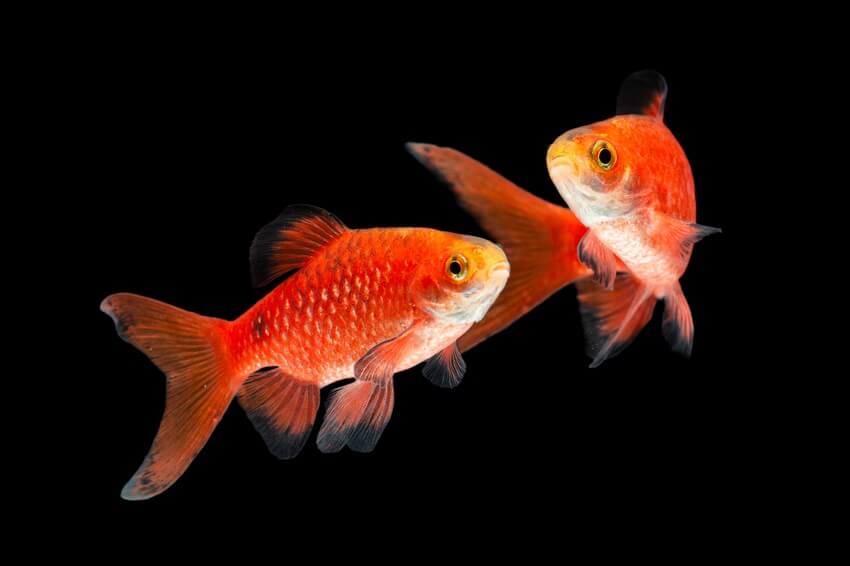
The only caveat here is shoaling behavior. Rosy barbs are social creatures that stay in a same-species group of at least five. Without that support system to fall back on, rosy barbs can turn to aggression and territorial behavior.
A larger group of rosy barbs can do a lot to keep all community members in check. They’ll pay attention to each other and leave the goldfish alone!
- Size: 6 inches
- Difficulty: Beginner
- Minimum Tank Size: 20 gallons
2. Platy Fish
Platies are another group-oriented species that do well as goldfish tank mates. Platy fish belong to the Xiphophorus genus, which includes tons of color morphs and unique varieties. You can find the humble platy fish in many cool colors and patterns, allowing you to get a distinct look that complements your goldfish!

These freshwater fish are livebearers. For this reason, some aquarists incorrectly believe that they’re incompatible with goldfish. The truth is that goldfish don’t pay any mind to adults!
Adult platies are wide-bodied, which is far too difficult for them to eat. However, the goldfish will eat any young fry that comes from platy spawning. With the penchant for frequent breeding that platy fish display, that behavior can be suitable for controlling the population.
- Size: 2.5 inches
- Difficulty: Beginner
- Minimum Tank Size: 10 gallons
3. Bristlenose Pleco
Bristlenose plecos have the vibe you’re looking for when it comes to goldfish tank mates. Despite their distinct appearance, these fish stay out of the way! They’re algae-eating bottom feeders that prefer to be discreet about their movements.

The best part of a bristlenose pleco is its ability to keep the tank clean. You can’t rely on these fish alone to eradicate algae. But, they will make a noticeable difference in the overall cleanliness of the tank.
Some believe that bristlenose plecos will consume the slime coat of your goldfish. While that is possible, it’s easy to avoid with proper feeding. Provide some sinking algae pellets to ensure that your Pleco has enough food sources throughout the tank.
- Size: 3 to 5 inches
- Difficulty: Beginner
- Minimum Tank Size: 25 gallons
4. Hillstream Loach
These unique little creatures have a distinct look! Many mistake them for miniature stingrays thanks to the expansive fins. While technically belonging to the loach family, hillstream loaches act like plecos.
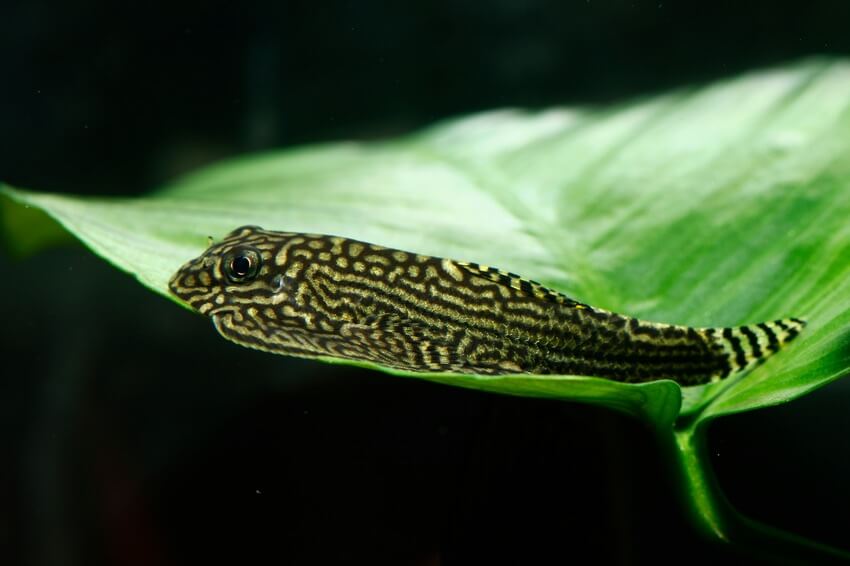
They spend their days clinging to glass and smooth surfaces to eat algae. Peaceful by nature, they like to stay out of sight and out of mind.
Hillstream loaches are fully capable of evading goldfish if they get a little daring. They usually won’t retaliate, either.
The hillstream loach adapts well to the cooler temperatures of goldfish environments. They can even make good pond fish if the conditions are right.
- Size: 2 to 3 inches
- Difficulty: Beginner-Intermediate
- Minimum Tank Size: 50 gallons
5. Hoplo Catfish
The hoplo catfish is native to South America. However, it can fare well in cooler temperatures thanks to its overall hardiness. These are resilient fish that can live in a wide range of environments.
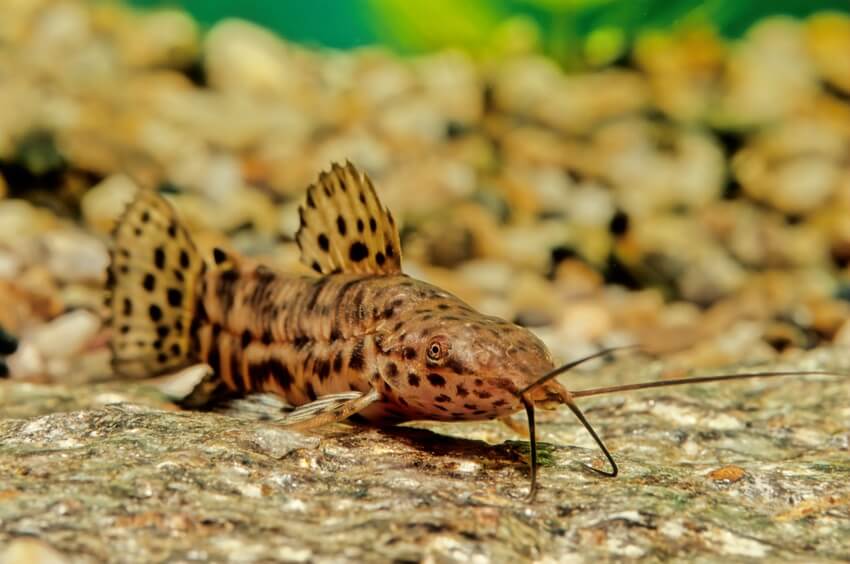
Somewhat reclusive, hoplo catfish aren’t huge fans of the hustle and bustle of busy aquariums (which is why they’re such good tank mates for goldfish). That’s not to say they won’t thrive in community tanks. But more often than not, you can find them hiding out underneath logs or within the foliage.
The good news is that hoplo catfish do feed during the day. So, you will see them scavenging for meals every once in a while.
- Size: 6 inches
- Difficulty: Beginner-Intermediate
- Minimum Tank Size: 55 gallons
6. Cherry Shrimp
Cherry shrimp are a great alternative to fish. They occupy the bottom of the water column and spend most of their day scavenging for food.

This particular species is very sought-after in the aquarium community. Thanks to their vibrant red body color, cherry shrimp are easy to spot. They add tons of unique colors to the tank, too.
Now, you do have to be a little wary of how goldfish react around cherry shrimp. These inverts can quickly become snacks for larger goldfish if you’re not careful.
The trick is to provide plenty of hiding places for the shrimp. Add many plants and stones, and these critters will be quite happy.
- Size: 1.5 inches
- Difficulty: Beginner
- Minimum Tank Size: 5 gallons
7. Banded Corydoras
Generally, cory catfish don’t make very good goldfish tank mates, but the banded corydoras is an exception. These freshwater fish are big enough not to become goldfish food.
They also happen to be a delight in larger communities! Highly sociable, banded corydoras need to stay in groups of at least five. With some other fish to fall back on, these critters are fun and playful.
Like most corydoras, this species has a sloped head and tiny barbs. They scavenge the bottom for food. However, they’re not shy enough to spend all their time towards the bottom. You’ll see them playing all over the tank.
- Size: 3.5 to 4 inches
- Difficulty: Beginner-Intermediate
- Minimum Tank Size: 55 gallons
8. Mystery Snail
Here’s another invertebrate that can cohabitate with goldfish. Like corydoras, snails aren’t the go-to for most aquarists when they’re searching for the best goldfish tank mates. However, the mystery snail is an outlier in the larger snail family.

It’s considerably bigger than other freshwater snails. The enormous shell offers ample protection against hungry and curious goldfish!
The best part of mystery snails is that they can improve the overall condition of the tank. They’re omnivores that eat everything from leftover food to plant detritus and algae! These snails will keep things clean, which is a huge plus.
- Size: 2 inches
- Difficulty: Beginner
- Minimum Tank Size: 5 gallons
9. Giant Danio
Giant danios are minnow fish that add a lot of sparkle to a tank. They have a similar look to their smaller cousins, zebra danios (you can find them further down on the list). However, a larger size results in more defined markings and some distinct colorations.
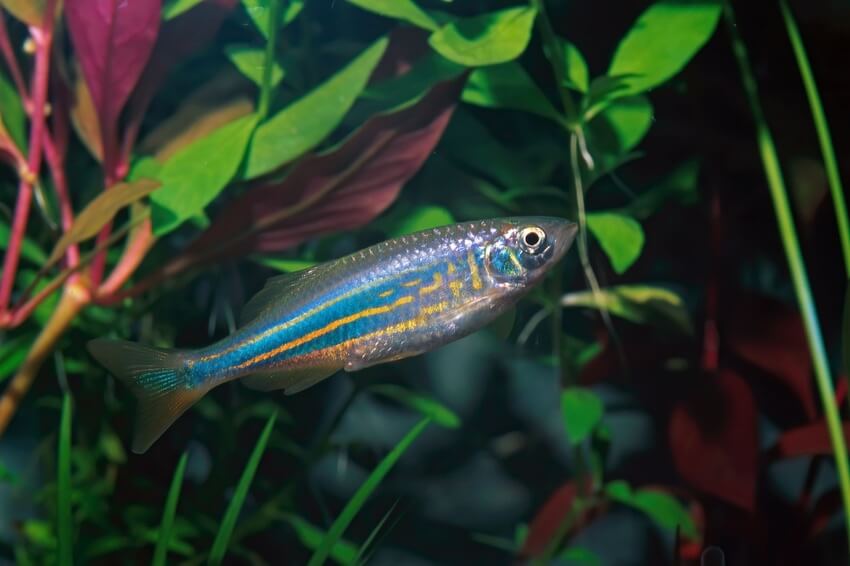
Overall, giant danios are a worthy addition to community tanks only if you have goldfish with similar behaviors. This species likes to school and swim around the tank quickly.
They aren’t going to serve you well if you have fancy goldfish or varieties that can’t swim well. However, they will coexist with comet goldfish and fast-swimming types.
- Size: 4 inches
- Difficulty: Beginner
- Minimum Tank Size: 30 gallons
10. White Cloud Mountain Minnow
Here’s another minnow-type fish worth checking out. From an aesthetics standpoint, White Cloud Mountain minnows are quite beautiful. They have silver-green scales, pinkish fins, and an iconic iridescent stripe that runs from the tail to the head.

At first glance, White Cloud Mountain minnows don’t seem to be a good companion for goldfish. But, they have all the hallmarks that prove otherwise.
These fish are native to cooler mountain streams. Right off the bat, they’re well-primed for the goldfish tank environment.
Not only that, but White Cloud Mountain minnows are fast and powerful swimmers. They can easily get out of the way of hungry goldfish while complementing the energy levels of fast-swimming varieties.
- Size: 1.5 inches
- Difficulty: Beginner
- Minimum Tank Size: 10 gallons
11. Rubber Lip Pleco
Rubber lip plecos are the quintessential algae-eater. They use their signature sucker mouth to latch onto glass and wipe the tank clean.
Most rubber lip plecos have that signature pleco profile. They’re sporting flattened bodies, unreturned mouths, and expansive rayed fins.
These fish are all about staying discrete. Their gray coloration and tan spots help them blend into the background of natural-looking decor.
For the most part, rubber lip plecos are great goldfish tank mates because they mind their own business. The only exception is whenever they’re not getting enough food. Make sure to provide supplementary algae wafers to ensure that the fish doesn’t turn to your goldfish for food.
- Size: 7 inches
- Difficulty: Beginner
- Minimum Tank Size: 25 to 30 gallons
12. Zebra Danio
Zebra danios are slim fish with torpedo-shaped bodies and iconic coloration. They’re appropriately named for the lateral stripes that adorn the body from head to tailfin.
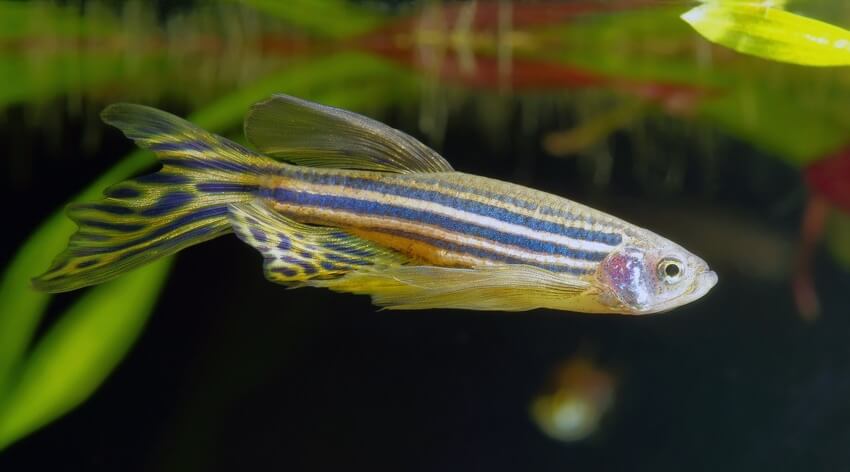
This species can tolerate the cooler conditions that goldfish need to thrive. Not only that, but they’re pretty peaceful, too.
Zebra danios are fast swimmers that can easily evade any goldfish that tests their luck. However, most goldfish aren’t even going to attempt to eat them.
Most zebra danios stick together in groups, which isn’t enticing for goldfish. Plus, they like to stay near filters and bubble walls.
- Size: 2 to 2.5 inches
- Difficulty: Beginner
- Minimum Tank Size: 10 gallons
13. Dojo Loach
Sometimes called the weather loach, these fish are a great option when it comes to goldfish tank mates. They have slim, sausage-like bodies and tiny fins. Some barbels around the mouth facilitate their hunt for food while the small pectoral finds help with navigation.
Dojo loaches are natural bottom-dwellers. They like to group up and lounge around as they watch other fish be more active above them.
These fish aren’t aggressive at all. Even when on the other end of aggressive behaviors, dojo loaches would much rather hide away and eat than get into a fight.
- Size: 6 inches
- Difficulty: Beginner
- Minimum Tank Size: 55 gallons
Species To Avoid
Any of the previously mentioned species should do just fine with your goldfish. However, there are many potential tank mates that you should avoid at all costs!
Never pair goldfish with aggressive tank mates like cichlids and bettas. Their natural territorial tendencies are no match for the innocent goldfish. Aggression will become a genuine problem, and goldfish aren’t capable of protecting themselves from attackers.
It’s also important to avoid any fish with a penchant for fin-nipping. For example, many types of tetras are quite common in community tanks. But in the presence of long-finned goldfish, they can become an aggressive nightmare!
You should also steer clear of any fish that has strict warm temperature requirements. That rules out molly fish, guppies, gouramis, and more.
Believe it or not, you must also think long and hard about housing different goldfish varieties in one tank. Obviously, multiple fancy goldfish will do well together, but keeping fast-swimming common goldfish with long-finned fancy goldfish is a big no-no.
Author Note: You must match personalities and energy levels. That includes all fish within the goldfish family as well.
Closing Thoughts
As you can see, the best goldfish tank mates have a lot in common. You’re looking for a freshwater species that’s peaceful, fine in cool water, not overly active, and reasonably sized.
The species on our list fit into this criteria, and we’re certain you’ll have a great experience using them as goldfish companions. If you have any questions about the viability of other fish, feel free to send them over.

